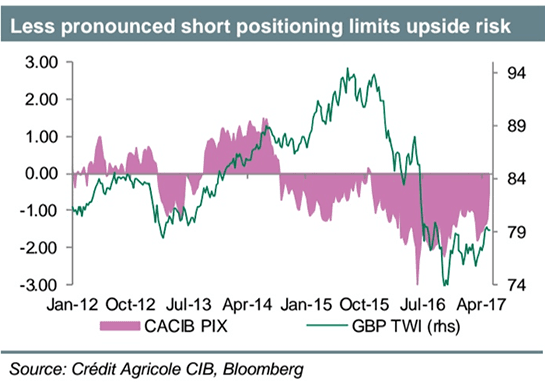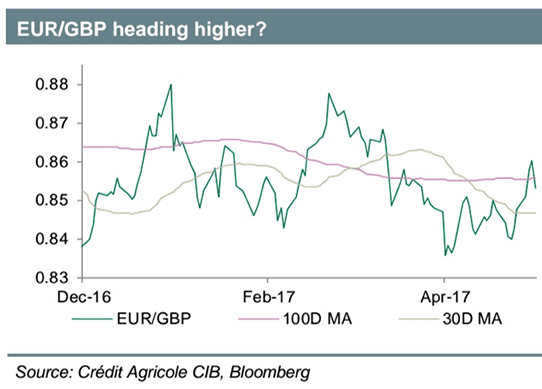Euro Strength to Extend say Credit Suisse, GBP/EUR Rate at 7-Week Low
- British Pound to Euro exchange rate on 23-5-17: 1.1548, day's best: 1.1573, low: 1.1526
- Euro to Pound Sterling exchange rate: 0.8660, day's best: 0.8675, low: 0.8640

A strategist at one of Europe’s leading research houses has confirmed his team are backing the Euro to rise against Pound Sterling in coming months.
Valentin Marinov, Head of G10 FX Strategy at Credit Agricole, sees, “scope for the EUR to appreciate in the quarters to come.”
The call comes at a time of increasing Euro strength on global foreign exchange markets as the risks clouding the Eurozone have cleared. Growth has stabilised and political risks have receded creating an optimistic mood amongst investors.
The Euro has taken a fresh leg higher at the time of writing after German Chancellor Merkel told an audience she believe the Euro was too weak.
"The chancellor, who seems set for re-election later this year, noted that the Euro seemed too weak," says Chris Beauchamp at IG. "This caused a frenzy of Euro buying, for who can blame traders for rushing in when Europe’s most powerful politician issues a trade idea?"
The GBP had meanwhile been benefitting from increased expectations of UK PM May being in a better position and having sufficient time in order to negotiate an acceptable exit deal since she called for a snap election.
These expectations have however since been questioned with a raft of polls showing voters are now taking a shine to the leftist Labour party at the expense of May's Conservatives.
Central Banks Matter
The Euro’s recent recovery comes as markets ready themselves for the day the European Central Bank (ECB) starts raising interests and turning off the money-printing presses.
This in turn is a result of the steadily improving inflation levels in the Eurozone which reflect a steadily improving economy.
“Regardless of the ECB’s still dovish policy stance we see scope for the EUR to appreciate in the quarters to come,” says Marinov.

Credit Agricole anticipate further prospect of the ECB QE taper becoming a more important EUR driver in H217.
“QE taper” refers to the process whereby the ECB brings to an end its multi-year policy of buying government and corporate bonds in an effort to keep the cost of lending across the Eurozone low.
The idea is that this would help stimulate economic growth in a region that has been slow to recover from the effects of the great credit crunch of 2008 and the ensuing sovereign debt crisis that struck early in the next decade.
The outlook in mid-2017 has also seen improvement as political uncertainty has been falling.
Elsewhere, an improving risk asset related capital flow situation may prove a more important currency driver later on as global investors continue to hunt out Eurozone stocks and other financial assets that are expected to outperform alongside the improving economic situation.
“The EUR-rally comes amidst the strongest cyclical upturn in the Eurozone in recent history. In particular, compared to previous EUR-bounces, the latest rally is taking place at a time when Eurozone PMIs are printing fresh cycle highs,” says Marinov.

This much could be sufficient for ECB’s Governing Council to conclude that improving business (and consumer) sentiment will usher in a period of sustained recovery that will help close the Eurozone output gap and boost wages growth, leaving the risks to the HICP (core) CPI projections to the upside.
As a result of the above, Credit Agricole say they prefer relative value trades like buying EUR/GBP in anticipation of further Euro strength.
“We remain of the view that the currency will underperform the EUR and we stay long EUR/GBP as a trade recommendation,” says Marinov. “We expect central bank monetary policy expectations to remain capped and such prospects should leave any GBP upside limited.”
Credit Agricole are forecasting the Euro to Pound Sterling exchange rate to end 2017 at 0.87 ahead of a gradual rise to 0.88 in mid-2018 and 0.89 by the end of 2018.
This equates to Pound / Euro exchange rate levels of 1.1494, 1.1364 and 1.1236.
Elsewhere, analysts at RBC Capital Markets have confirmed they are retaining their tactical trade that seeks to take advantage of further EUR/GBP upside.
"As was the case in the run-up to the EU referendum, however, we expect shifts in market expectations for June 8 to throw up tactical trading opportunities and we currently favour being tactically short GBP," says Adam Cole, analyst with RBC Capital Markets in London.
RBC Capital maintain a medium-term negative view on GBP driven largely by a concern that UK growth expectations may already have overshot to the upside and that export performance following previous GBP falls will persistently disappoint.
No Stopping the Euro Express
The real driver of foreign exchange markets at present is the Euro which has come into favour with global investors in a big way of late.
The Euro is charging higher again thanks to two sets of impressive Eurozone economic statistics released today.
Data from IHS Markit showed that firms are seeing business expand at its strongest pace in six years, giving rise to expectations for a strong quarter for the Eurozone economy.
The composite PMI for May - a broad-based assessment of the business activity of Eurozone firms - read at 56.8, analysts had forecast a reading of 56.6.
“Capacity is being strained by the strength of demand, with backlogs of work showing one of the largest increases in the past six years. Job creation has surged to the second-highest rate in nearly a decade as firms seek to expand capacity and meet rising demand,” says Chris Williamson, Chief Business Economist at IHS Markit.
Meanwhile, data out from Germany was equally impressive.
The Ifo index rose further from 113.0 to 114.6 (Consensus: 113.1).
This is a record high since the index was started in 1991 after reunification.
Business expectations were up strongly from 105.2 to 106.5.
The current assessment component surged from 121.4 to 123.2 and hence also to its highest level since 1991.
When looking at sectors, especially manufacturing and construction companies became again more optimistic.
Both the forward-looking expectations and the current assessment components among manufacturers increased.
The current assessment figure in the construction industry hit another record-high level.
Undoubtedly the news is good for the Eurozone outlook and we would expect the Euro to remain supported. But the chance of such surprises being repeated in future months are unlikely.
“The latest renewed and strong rise in German business sentiment is great news. However, the air for further improvement is increasingly getting thin. While it is impossible to forecast exactly when the peak will be reached, it is clear that we are getting close to it. Repeatedly strong increases in the next few months towards levels seen before reunification (i.e. sentiment among companies in Western Germany) are unlikely in our view,” says Dr. Andreas Rees at UniCredit Research.





